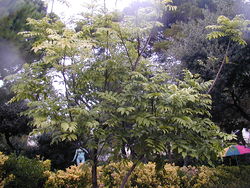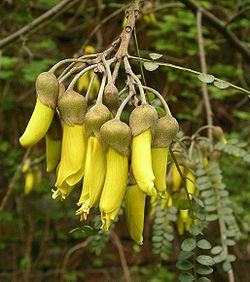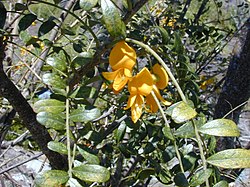Sophoreae
| Sophoreae | ||||||||||||
|---|---|---|---|---|---|---|---|---|---|---|---|---|
 Sophora denudata | ||||||||||||
| Systematik | ||||||||||||
| ||||||||||||
| Wissenschaftlicher Name | ||||||||||||
| Sophoreae | ||||||||||||
| Spreng. ex DC. |
Sophoreae ist eine Tribus in der Unterfamilie der Schmetterlingsblütler (Faboideae) innerhalb der Familie der Hülsenfrüchtler (Fabaceae).
Beschreibung


Vegetative Merkmale
Es sind meist verholzende Pflanzen: immergrüne oder laubabwerfende Sträucher und Bäume, selten sind es Lianen (Beispiel: Bowringia callicarpa); oder ausdauernde krautige Pflanzen.
Die Laubblätter sind oft gefiedert oder gefingert. Nebenblätter sind vorhanden oder fehlen.
Generative Merkmale
Es werden seiten- oder endständige, traubige oder rispige Blütenstände gebildet.
Die Blüten sind zygomorph bis fast radiärsymmetrisch und oft fünfzählig mit doppelter Blütenhülle. Es kann ein Blütenbecher vorhanden sein. Die fünf Kelchblätter sind unterschiedlich weit verwachsen. Die selten ein bis, meist fünf Kronblätter können weiß, gelb oder lila sein. Es sind meist zehn (sechs bis dreißig) Staubblättern vorhanden. Die Staubfäden können alle vollkommen frei sein oder die äußersten bis auf der Hälfte ihrer Länge verwachsen sein, selten sind neun bis weit nach oben verwachsen. Die Staubbeutel sind alle gleich. Das einzelne Fruchtblatt enthält ein bis einige Samenanlagen.
Es werden nicht bei allen Arten Hülsenfrüchte gebildet, sondern auch Flügelnüsse (Samaras) die geflügelt sind. Die nierenförmigen, elliptischen oder kugeligen Samen besitzen ein kleines Hilum und manchmal einen Arillus.
Chromosomensätze
Die Chromosomengrundzahlen im Tribus reichen von x = 8 bis 14, am häufigsten sind x = 11 und x = 9.













Systematik und Verbreitung
Die Tribus Sophoreae wurde 1825 durch Curt Polycarp Joachim Sprengel in Augustin Pyramus de Candolle: Prodromus Systematis Naturalis Regni Vegetabilis, 2, S. 94 aufgestellt.[1][2] Reaktiviert wurde die Tribus Sophoreae 1981 durch Roger Marcus Polhill: Sophoreae. S. 213–230, in: R. M. Polhill, P. H. Raven (Hrsg.): Advances in Legume Systematics.[3]
Die Tribus Sophoreae gehört zur Unterfamilie der Faboideae innerhalb der Familie der Fabaceae.[4] Die Arten dieser Tribus gehören zu den ursprünglichsten in dieser Unterfamilie.
Arten der Tribus Sophoreae gedeihen in den tropischen und gemäßigten Gebieten der Neuen Welt und der Alten Welt.
Die Tribus Sophoreae enthält 42 bis 46 Gattungen (vollständige Liste nach GRIN[4]) mit etwa 370 bis 400 Arten[5]:
- AcosmiumSchott: Sie enthält etwa 16 Arten:[5]
- Acosmium bijugum(Vogel) Yakovlev
- Acosmium brachystachyum(Benth.) Yakovlev
- Acosmium dasycarpum(Vogel) Yakovlev
- Acosmium diffusissimum(Mohlenbr.) Yakovlev
- Acosmium fallax(Taub.) Yakovlev
- Acosmium glaziovianum(Harms) Yakovlev
- Acosmium lentiscifoliumSchott
- Acosmium mohlenbrockiiYakovlev
- Acosmium nitens(Vogel) Yakovlev
- Acosmium panamense(Benth.) Yakovlev
- Acosmium parvifolium(Harms) Yakovlev
- Acosmium praeclarum(Sandwith) Yakovlev
- Acosmium subelegans(Mohlenbr.) Yakovlev
- Acosmium tenuifolium(Vogel) Yakovlev
- Acosmium tomentellum(Mohlenbr.) Yakovlev
- Acosmium trichonemaRizzini
- AiryanthaBrummitt: Die etwa zwei Arten sind im tropischen Afrika und Asien verbreitet:[5]
- Airyantha borneensis(Oliv.) Brummitt
- Airyantha schweinfurthii(Taub.) Brummitt
- AlexaMoq.: Es ist eine rein neotropische Gattung mit etwa neun Baum-Arten:[5]
- Alexa bauhiniifloraDucke
- Alexa canaracunensisPittier
- Alexa confusaPittier
- Alexa cowaniiYakovlev
- Alexa grandifloraDucke
- Alexa herminianaN.Ramírez
- Alexa imperatricis(R.H.Schomb.) Baill.
- Alexa leiopetalaSandwith
- Alexa surinamensisYakovlev
- Alexa wachenheimiiBenoist
- AmmodendronFisch. ex DC.: Die vier bis acht Strauch-Arten kommen vom Iran bis Xinjiang vor:[5]
- Ammodendron bifolium(Pall.) Yakovlev
- Ammodendron conollyiBoiss.
- Ammodendron eichwaldiiLedeb.
- Ammodendron kareliniiFisch. & C.A.Mey.
- AmphimasPierre ex Harms: Die drei bis vier Arten sind in West- bis Zentralafrika verbreitet:[5]
- Amphimas ferrugineusPellegr.
- Amphimas pterocarpoidesHarms
- Amphimas tessmanniiHarms
- AngylocalyxTaub.: Sie enthält etwa fünf Arten:[5]
- Angylocalyx boutiqueanusL.Touss.
- Angylocalyx brauniiHarms
- Angylocalyx oligophyllus(Baker) Baker f.
- Angylocalyx pynaertiiDe Wild.
- Angylocalyx schumannianusTaub.
- BaphiaAfzel. ex Lodd. et al. (Syn.: BracteolariaHochst.): Die etwa zwei Arten kommen im tropischen Afrika und in Madagaskar vor:[5]
- Baphia capparidifoliaBaker
- Baphia madagascariensisC.H.Stirt. & Du Puy
- BolusanthusHarms: Es gibt nur eine Art:[5]
- BowdichiaKunth: Sie enthält zwei bis vier Arten, die in Costa Rica und in Südamerika vorkommen:[5]
- Bowdichia nitidaBenth.
- Bowdichia virgilioidesKunth
- CadiaForssk. (Syn.: PanciaticaG.Piccioli, PseudocadiaHarms): Sechs Arten kommen in Madagaskar vor und eine Art ist in Äthiopien, Kenia sowie Somalia verbreitet:[5]
- Cadia commersonianaBaill.
- Cadia ellisianaBaker
- Cadia emarginatiorM.Pelt.
- Cadia pedicellataBaker
- Cadia pubescensBojer ex Baker
- Cadia purpurea(G.Piccioli) Aiton: Äthiopien, Kenia, Somalia[5]
- Cadia rubraR.Vig.
- CamoensiaWelw. ex Benth. & Hook. f. (Syn.: GiganthemumWelw.): Die etwa zwei Arten kommen von Nigeria bis Angola vor:
- Camoensia brevicalyxBenth.
- Camoensia scandens(Welw.) J.B.Gillett
- CastanospermumA.Cunn. ex Hook.: Sie enthält ein oder zwei Arten im subtropischen Australien und Neukaledonien:[5]
- Australische Kastanie (Castanospermum australeA.Cunn. & C.Fraser ex Hook.)
- CladrastisRaf. (Syn.: Platyosprion(Maxim.) Maxim.): Sie enthält vier bis sieben Arten:[5]
- Amerikanisches Gelbholz (Cladrastis kentukea(Dum. Cours.) Rudd)
- Cladrastis parvifoliaC.Y.Ma
- Cladrastis platycarpa(Maxim.) Makino
- Cladrastis scandensC.Y.Ma
- Cladrastis sikokiana(Makino) Makino
- Cladrastis sinensisHemsl.
- Cladrastis wilsoniiTakeda
- Clathrotropis(Benth.) Harms: die etwa sechs Arten kommen im tropischen Südamerika und auf Karibischen Inseln vor:[5]
- Aromata (Clathrotropis brachypetala(Tul.) Kleinhoonte)
- Clathrotropis brunneaAmshoff
- Clathrotropis glaucophyllaCowan
- Clathrotropis macrocarpaDucke
- Clathrotropis nitida(Benth.) Harms
- DalhousieaWall. ex Benth.: Die etwa drei Arten kommen im tropischen Zentralafrika und von Assam bis Myanmar vor:[5]
- Dalhousiea africanaS.Moore
- Dalhousiea bracteata(Roxb.) Benth.
- Dalhousiea paucispermaGriff.
- DermatophyllumScheele: Seit 2011 ist dies der gültige Name für CaliaTerán & Berland, ein weiteres Synonym ist AgastianisRaf. nom. illeg. Es sind fünf Arten enthalten:[6]
- Dermatophyllum arizonicum(S.Watson) Vincent (Syn.: Sophora arizonicaS.Watson, Calia arizonica(S.Watson) Yakovlev, Sophora formosaKearney & Peebles, Calia formosa(Kearney & Peebles) Yakovlev, Calia arizonica subsp. formosa(Kearney & Peebles) Yakovlev)[6]
- Dermatophyllum gypsophilum (B.L.Turner & A.M.Powell) Vincent (Syn. Sophora gypsophilaB.L.Turner & A.M.Powell): Es gibt zwei Unterarten:[6]
- Meskalbohne (Dermatophyllum secundiflorum(Ortega) Gandhi & Reveal, Syn.: Broussonetia secondifloraOrtega, Calia secundiflora(Ortega) Yakovlev, Cladrastis secundiflora(Ortega) Raf., Sophora secundiflora(Ortega) Lagerh. ex DC., Virgilia secundiflora(Ortega) Cav.)[6]
- Dermatophyllum speciosumScheele[6]
- Dermatophyllum purpusii(Brandegee) Vincent (Syn. Sophora purpusiiBrandegee, Calia purpusii(Brandegee) Yakovlev)[6]
- DicraeopetalumHarms (Syn.: LovanafiaM.Peltier): Die nur zwei Arten sind in Madagaskar verbreitet:[7]
- Dicraeopetalum capuronianum(M.Pelt.) Yakovlev
- Dicraeopetalum mahafaliense(M.Pelt.) Yakovlev
- DiplotropisBenth.: Die etwa zwölf Arten sind in Südamerika (Kolumbien und Venezuela bis Peru und Bolivien) verbreitet.
- DussiaKrug & Urb. ex Taub. (Syn.: CashaliaStandl., VexilliferaDucke): Die etwa zehn Arten sind von Mexiko bis ins tropische Südamerika verbreitet:[5]
- Dussia coriaceaPierce
- Dussia cuscatlanica(Standl.) Standl. & Steyerm.
- Dussia discolor(Benth.) Amshoff
- Dussia foxiiRudd
- Dussia lehmanniiHarms
- Dussia macroprophyllata(Donn. Sm.) Harms
- Dussia martinicensisTaub.
- Dussia mexicana(Standl.) Harms
- Dussia sanguineaUrb. & Ekman
- Dussia tessmanniiHarms
- HaplormosiaHarms: Sie enthält nur eine Art:
- Haplormosia monophylla(Harms) Harms: Sie ist von West- bis Zentralafrika (Sierra Leone bis Gabun) verbreitet.
- LeucomphalosBenth. ex Planch. (Syn.: BaphiastrumHarms): Sie enthält nur eine Art:[5]
- Leucomphalos mildbraedii(Harms) Breteler: Sie kommt im tropischen Afrika und auf Madagaskar vor.[5]
- LuetzelburgiaHarms: Die etwa elf Arten kommen in Kolumbien, Brasilien und Bolivien vor:[5]
- Luetzelburgia andrade-limaeH.C.Lima
- Luetzelburgia auriculata(Allemao) Ducke
- Luetzelburgia bahiensisYakovlev
- Luetzelburgia guaissaraToledo
- Luetzelburgia pallidiflora(Rizzini) H.C.Lima
- Luetzelburgia praecox(Harms) Harms
- Luetzelburgia reitziiBurkart
- Luetzelburgia trialata(Ducke) Ducke
- MaackiaRupr. (Syn.: BuergeriaMiq.): Die etwa zehn Arten sind in Ostasien verbreitet.[5]
- MonopteryxSpruce ex Benth.: Die drei bis vier Arten sind im nördlichen Südamerika (Kolumbien, Venezuela, Französisch-Guyana und Amazonas-Gebiet Brasiliens) verbreitet:[5]
- Monopteryx angustifoliaBenth.
- Monopteryx inpaeW.A.Rodrigues
- Monopteryx uaucuBenth.
- MyrocarpusAllemão: Die etwa fünf Arten sind in Südamerika verbreitet.[5]
- Myrocarpus emarginatus A.L.B.Sartori & A.M.G.Azevedo
- Myrocarpus fastigiatusAllemão
- Myrocarpus frondosusAllemão
- Myrocarpus leprosusPickel
- Myrocarpus venezuelensisRudd
- MyrospermumJacq.: Sie enthält nur eine Art:
- Myrospermum frutescensJacq.: Sie kommt von Mexiko bis Venezuela und auf Trinidad vor.[5]
- Balsambäume (MyroxylonL. f., Syn.: ToluiferaL.):[5] Die seit 2015 nur noch zwei Arten sind in der Neotropis verbreitet.
- NeoharmsiaR.Vig.: Die nur zwei Arten kommen nur im nördlichen bis nordwestlichen Madagaskar vor:[7]
- Neoharmsia baronii(Drake) R.Vig. emend. Peltier
- Neoharmsia madagascariensisR.Vig.
- OrmosiaJacks. (Syn.: Anatropostylia(Plitmann) Kupicha, FedorouiaYakovlev, LayiaHook. & Arn., MacrotropisDC., MacroulePierce, OrmosiopsisDucke, PlacolobiumMiq., PodopetalumF.Muell., RuddiaYakovlev, ToulichibaAdans., TrichocyamosYakovlev): Die 90 bis 150 Arten sind in des Subtropen bis Tropen in Asien, in der Neuen Welt und in Australasien beispielsweise im australischen Bundesstaat Queensland verbreitet.[5][8][9]
- PanureaSpruce ex Benth. & Hook. f.: Sie enthält ein oder zwei Arten in Kolumbien und Brasilien:
- Panurea longifoliaBenth.
- PericopsisThwaites (Syn.: AfrormosiaHarms): Die etwa vier Arten kommen im tropischen Afrika, auf Sri Lanka und von Malesien bis zu den Karolinen vor:[5]
- Pericopsis angolensis(Baker) Meeuwen
- Pericopsis elata(Harms) Meeuwen
- Pericopsis laxiflora(Baker) Meeuwen
- Pericopsis moonianaThwaites
- PetaladeniumDucke: Sie enthält nur eine Art:[5]
- Petaladenium urceoliferumDucke: Dieser Endemit kommt nur am Rio Negro in Brasilien vor.
- SakoanalaR.Vig.: Die nur zwei Arten kommen nur in Madagaskar vor:[7]
- Sakoanala madagascariensisR.Vig.
- Sakoanala villosaR.Vig.
- SalweeniaBaker f.: Sie enthält nur eine Art:
- Schnurbäume (SophoraL., Syn.: BroussonetiaOrtega, Cephalostigmaton(Yakovlev) Yakovlev, EchinosophoraNakai, EdwardsiaSalisb., GoebeliaBunge ex Boiss., KeyserlingiaBunge ex Boiss., VexibiaRaf.): Es gibt etwa 70 Arten,[5] Auswahl:
- Sophora albescens(Rehder) C.Y.Ma: Sie kommt in Sichuan und in Yunnan vor.[5]
- Sophora albo-petiolulataLéonard
- Sophora alopecuroidesL.
- Sophora arizonicaS.Watson
- Sophora bakeriPrain
- Sophora benthamiiSteenis
- Sophora brachygynaC.Y.Ma
- Sophora chrysophylla(Salisb.) Seem.
- Sophora conzattiiStandl.
- Sophora davidii(Franch.) Pavol.
- Sophora denudataBory
- Sophora microphyllaAit.
- Sophora tetrapteraJ.F.Mill.
- Sophora tomentosaL.
- Sophora tonkinensisGagnep.
- Toromiro (Sophora toromiroSkottsb.): Dieser Endemit kommt nur auf der Osterinsel vor.
- SpirotropisTul.: Die zwei bis drei Arten sind im nördlichen Südamerika (Venezuela, Guyana, Surinam, Französisch-Guyana und Amazonas-Gebiet Brasiliens) verbreitet.
- StyphnolobiumSchott: Sie enthält etwa neun Arten, die in China und von den Vereinigten Staaten bis Kolumbien vorkommen:[5]
- Styphnolobium affine(Torr. & A.Gray) Walp. (Syn.: Sophora affinisTorr. & A.Gray)
- Styphnolobium burseroidesM.Sousa, Rudd & Medrano
- Styphnolobium caudatumM.Sousa & Rudd
- Styphnolobium conzattii(Standl.) M.Sousa & Rudd
- Japanischer Schnurbaum (Styphnolobium japonicum(L.) Schott, Syn.: Sophora japonicaL.)
- Styphnolobium monteviridisM.Sousa & Rudd
- Styphnolobium parviflorumM.Sousa & Rudd
- Styphnolobium protantherumM.Sousa & Rudd
- Styphnolobium sporadicumM.Sousa & Rudd
- SweetiaSpreng. (Syn.: FerreireaAllemão): Die etwa zwei Arten kommen in Südamerika vor:[5]
- Sweetia atrataMohlenbr.
- Sweetia fruticosaSpreng.
- UleanthusHarms: Es gibt nur eine Art:[5]
- Uleanthus erythrinoidesHarms: Sie ist im Amazonas-Gebiet verbreitet.
- UribeaDugand & Romero: Sie enthält nur eine Art:[5]
- Uribea tamarindoidesDugand & Romero: Sie kommt in Costa Rica und Kolumbien vor.
- XanthocercisBaill.: Sie enthält zwei Arten:[4]
- Xanthocercis madagascariensisBaill. (Syn.: Cadia anomalaVatke, Pseudocadia anomala(Vatke) Harms): Sie gedeiht in Höhenlagen von 0 bis 500 Metern in Madagaskar nur in den Provinzen Antsiranana, Mahajanga und Toamasina.[7]
- Xanthocercis zambesiaca(Baker) Dumaz-le-Grand Sie kommt von Mosambik über Malawi, Sambia, Simbabwe, dem nördlichen Botswana bis Südafrika vor.[4]
Quellen
Literatur
- Hang Sun, Bojian Bao, Michael A. Vincent: Sophoreae., S. 72 – textgleich online wie gedrucktes Werk, In: Wu Zheng-yi, Peter H. Raven & Deyuan Hong (Hrsg.): Flora of China, Volume 10 – Fabaceae, Science Press und Missouri Botanical Garden Press, Beijing und St. Louis, 2010, ISBN 978-1-930723-91-7. (Abschnitte Beschreibung und Systematik)
- D. Cardoso, R. T. Pennington, L. P. de Queiroz, J. S. Boatwright, B.-E. Van Wyk, M. F. Wojciechowski, M. Lavin: Reconstructing the deep-branching relationships of the papilionoid legumes In: S. Afr. J. Bot., Volume 89, 2013, S. 58–75. doi:10.1016/j.sajb.2013.05.001
- M. F. Wojciechowski: Towards a new classification of Leguminosae: Naming clades using non-Linnaean phylogenetic nomenclature. In: S. Afr. J. Bot., Volume 89, 2013, S. 85–93. doi:10.1016/j.sajb.2013.06.017
- Kanchi N. Gandhi, Michael A. Vincent, James L. Reveal: Dermatophyllum, the correct name for Calia (Fabaceae). In: Phytoneuron, 2011–57, S. 1–4. Volltext-PDF.
Einzelnachweise
- ↑ Curt Polycarp Joachim Sprengel in Augustin Pyramus de Candolle: Prodromus Systematis Naturalis Regni Vegetabilis, 2, 1825, S. 94. eingescannt bei biodiversitylibrary.org.
- ↑ Sophoreae bei Tropicos.org. Missouri Botanical Garden, St. Louis, abgerufen am 23. Oktober 2021.
- ↑ Roger Marcus Polhill: Sophoreae. S. 213–230. In: R. M. Polhill, P. H. Raven (Hrsg.): Advances in Legume Systematics, Parts 1 and 2. Royal Botanic Gardens, Kew, 1981, ISBN 978-0-85521-224-7.
- ↑ a b c d Sophoreae im Germplasm Resources Information Network (GRIN), USDA, ARS, National Genetic Resources Program. National Germplasm Resources Laboratory, Beltsville, Maryland. Abgerufen am 14. Mai 2015.
- ↑ a b c d e f g h i j k l m n o p q r s t u v w x y z aa ab ac ad ae af ag ah ai Taxon in Suchfenster eingeben bei International Legume Database – ILDIS = International Legume Database & Information Service, Version 10.01. vom November 2005.
- ↑ a b c d e f g h Kanchi N. Gandhi, Michael A. Vincent, James L. Reveal: Dermatophyllum, the correct name for Calia (Fabaceae). In: Phytoneuron, 2011–57, S. 1–4. Volltext-PDF.
- ↑ a b c d Fabaceae bei Tropicos.org. In: Catalogue of the Vascular Plants of Madagascar. Missouri Botanical Garden, St. Louis
- ↑ Sawai Mattapha, Somran Suddee, Sukid Rueangruea: Notes on the genus Ormosia (Fabaceae-Sophoreae) in Thailand. In: Thai Forest Bulletin (Botany), Volume 45, Issue 2, 2017, S. 118–124. doi:10.20531/tfb.2017.45.2.07
- ↑ Benjamin Torke, Domingos Cardoso, Hsuan Chang, Shijin Li, Miao Niu, R. Pennington, Charles Stirton, Wei-Bin Xu, Charles Zartman, Kuo-Fang Chung: A dated molecular phylogeny and biogeographical analysis reveals the evolutionary history of the trans-Pacifically disjunct tropical tree genus Ormosia (Fabaceae). In: Molecular Phylogenetics and Evolution, Volume 166, Oktober 2021, 107329. doi:10.1016/j.ympev.2021.107329
Weblinks
- Informationen zur Gattung Myrocarpus und zur Tribus. (port. + engl. abstract)
- M. Noori, M. S. J. Simmonds, M. Ingrouille: Chromosome studies of iranian members of Tribe Sophoreae (Family Leguminosae). In: Journal of Sciences Islamic Republic of Iran, Volume 12, Issue 2, 2001, S. 111–116. Volltext-PDF.
- Artenzahlen und Verbreitung einzelner Gattungen bei Legumes of the world.
- Sophoreae bei Tropicos.org. In: Flora of Pakistan. Missouri Botanical Garden, St. Louis
Weiterführende Literatur
- R. T. Pennington, C. H. Stirton, B. D. Schrire: Tribe Sophoreae. In: G. Lewis, B. Schrire, B. Mackinder, M. Lock: Legumes of the World. Royal Botanic Gardens, Kew, 2005, ISBN 1-900347-80-6, S. 227–249.
Auf dieser Seite verwendete Medien
Autor/Urheber: Die Autorenschaft wurde nicht in einer maschinell lesbaren Form angegeben. Es wird B.navez als Autor angenommen (basierend auf den Rechteinhaber-Angaben)., Lizenz: CC BY-SA 3.0
Autor/Urheber: SAplants, Lizenz: CC BY-SA 4.0
Xanthocercis zambesiaca, flowers; Limpopo River Valley, Little Mokolodi, Central District, Botswana
(c) Forest & Kim Starr, CC BY 3.0
Sophora chrysophylla (flowers and leaves). Location: Maui, Auwahi
Illustration from book
Autor/Urheber: Jean-Pol GRANDMONT, Lizenz: CC BY 3.0
Maackia amurensis
Autor/Urheber: Le.Loup.Gris, Lizenz: CC BY-SA 3.0
Sophora Root (Sophora alopecuroides L.). Habitat: meadow near a railroad. Vicinity of Saratov city, Russia.
Illustration from book
Autor/Urheber: Miwasatoshi, Lizenz: CC BY-SA 4.0
Calia secundiflora, cultivated, Arizona State University, Tempe, Arizona
(c) Forest & Kim Starr, CC BY 3.0
Sophora tomentosa (flowers). Location: Florida, Deering Park
Autor/Urheber: Tatiana Gerus from Brisbane, Australia, Lizenz: CC BY 2.0
Bolusanthus speciosus Rhodesian-wisteria-tree
Native to south AfricaAutor/Urheber: Jean-Pol GRANDMONT, Lizenz: CC BY 3.0
Japanische Schnurbaum
Autor/Urheber: Yuriy75, Lizenz: CC BY-SA 3.0
Ammodendron sp. Near Baikonur, Kazakhstan.
Autor/Urheber: Sonké, B.; Couvreur, T, Lizenz: CC BY 4.0
Amphimas pterocarpoides (Fabaceae) in the Dja Faunal Reserve. Photo: TLP Couvreur.
Autor/Urheber: Michael Wolf, Lizenz: CC BY-SA 3.0
Sophora spp. im Botanischen Garten Dresden - vielleicht Sophora davidii.
Autor/Urheber: yakovlev.alexey from Moscow, Russia, Lizenz: CC BY-SA 2.0
Monogaga



















